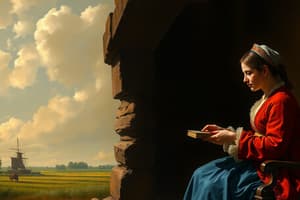Podcast
Questions and Answers
What technique did Rembrandt use in 'The Card Player' to create rich tonal effects?
What technique did Rembrandt use in 'The Card Player' to create rich tonal effects?
- Oil painting and glazing
- Watercolor and washes
- Block printing and embossing
- Drypoint and burnishes (correct)
In which year did Rembrandt create 'Christ and the Woman of Samaria: Among Ruins'?
In which year did Rembrandt create 'Christ and the Woman of Samaria: Among Ruins'?
- 1656
- 1648
- 1634 (correct)
- 1629
What aspect of Rembrandt's self-portraits are scholars most divided over?
What aspect of Rembrandt's self-portraits are scholars most divided over?
- The frequency of reproduction
- The choice of subjects depicted
- The choice of materials
- The motivation behind their creation (correct)
What significant Biblical interaction does Rembrandt depict in 'Christ and the Woman of Samaria: Among Ruins'?
What significant Biblical interaction does Rembrandt depict in 'Christ and the Woman of Samaria: Among Ruins'?
Which element is emphasized in 'Self Portrait Drawing at a Window'?
Which element is emphasized in 'Self Portrait Drawing at a Window'?
What was one revolutionary aspect of Rembrandt's approach to his self-portraits?
What was one revolutionary aspect of Rembrandt's approach to his self-portraits?
Why are Rembrandt's Biblical subjects particularly significant among collectors?
Why are Rembrandt's Biblical subjects particularly significant among collectors?
What does the extensive cross-hatching in 'The Card Player' primarily serve to highlight?
What does the extensive cross-hatching in 'The Card Player' primarily serve to highlight?
What year was 'The Artist’s Mother with Her Hand on Her Chest' created?
What year was 'The Artist’s Mother with Her Hand on Her Chest' created?
What does the position of the mother's hand on her chest in Rembrandt's portrait suggest?
What does the position of the mother's hand on her chest in Rembrandt's portrait suggest?
What aspect of Rembrandt's style is exemplified in the portrait of his mother?
What aspect of Rembrandt's style is exemplified in the portrait of his mother?
What speculation exists about the subject of 'Bust of a Man Wearing a High Cap; Three-Quarters'?
What speculation exists about the subject of 'Bust of a Man Wearing a High Cap; Three-Quarters'?
What element of the subject's attire in 'Bust of a Man Wearing a High Cap' suggests importance?
What element of the subject's attire in 'Bust of a Man Wearing a High Cap' suggests importance?
In which etching does Rembrandt demonstrate mastery in depicting character through facial expression?
In which etching does Rembrandt demonstrate mastery in depicting character through facial expression?
What characteristic of the sitter in 'The Card Player' is notable?
What characteristic of the sitter in 'The Card Player' is notable?
What was Rembrandt's mother's name?
What was Rembrandt's mother's name?
What significant event occurred in 1993 related to Rembrandt's etching plates?
What significant event occurred in 1993 related to Rembrandt's etching plates?
How many impressions of each image from Rembrandt's original copper plates were created in the recent edition?
How many impressions of each image from Rembrandt's original copper plates were created in the recent edition?
What artistic technique did Rembrandt utilize in the etching 'The Golf Player'?
What artistic technique did Rembrandt utilize in the etching 'The Golf Player'?
What may 'Landscape with a Cow Drinking' symbolize about Rembrandt's life during its creation?
What may 'Landscape with a Cow Drinking' symbolize about Rembrandt's life during its creation?
Which artist was NOT mentioned as being influenced by Rembrandt's etchings?
Which artist was NOT mentioned as being influenced by Rembrandt's etchings?
What landscape elements did Rembrandt incorporate in 'Landscape with a Cow Drinking'?
What landscape elements did Rembrandt incorporate in 'Landscape with a Cow Drinking'?
What was the condition of Rembrandt's financial situation when he created 'Landscape with a Cow Drinking'?
What was the condition of Rembrandt's financial situation when he created 'Landscape with a Cow Drinking'?
What is one of the notable features of Rembrandt's etchings as recognized by collectors and historians?
What is one of the notable features of Rembrandt's etchings as recognized by collectors and historians?
What significant life event followed Rembrandt during the six years he did not create self-portraits?
What significant life event followed Rembrandt during the six years he did not create self-portraits?
Which aspect of Rembrandt's work 'The Raising of Lazarus' is highlighted as a key feature?
Which aspect of Rembrandt's work 'The Raising of Lazarus' is highlighted as a key feature?
How many variations did Rembrandt create during the evolution of 'The Raising of Lazarus'?
How many variations did Rembrandt create during the evolution of 'The Raising of Lazarus'?
What does the darkness surrounding the figures in 'The Raising of Lazarus' symbolize?
What does the darkness surrounding the figures in 'The Raising of Lazarus' symbolize?
What emotion do the faces of the onlookers convey in 'The Raising of Lazarus'?
What emotion do the faces of the onlookers convey in 'The Raising of Lazarus'?
At what age did Rembrandt create his last etched self-portrait?
At what age did Rembrandt create his last etched self-portrait?
What describes the style of Rembrandt's artwork during the Baroque period?
What describes the style of Rembrandt's artwork during the Baroque period?
How was 'The Raising of Lazarus' received by contemporary collectors?
How was 'The Raising of Lazarus' received by contemporary collectors?
Flashcards are hidden until you start studying
Study Notes
Rembrandt's Etchings and Their Impact
- Rembrandt's etchings are considered some of the finest examples of the medium, influencing artists such as Goya, Picasso, and Chagall.
- After his death in 1669, Rembrandt's copper etching plates remained intact until 1993, when they were sold at the London Original Print Fair, creating significant interest among collectors.
Important Collectors and Reproductions
- Collector Howard Berger acquired eight of Rembrandt’s plates and collaborated with master printers Emiliano Sorini and Marjorie Van Dyke to produce a limited edition of 2,500 impressions from the originals.
Key Etchings and Their Significance
"Landscape with a Cow Drinking" (ca. 1650)
- Combines local Amsterdam landscapes with distant mountains, reflecting Rembrandt's longing for peace during financial troubles.
- Delicate linework enhances the atmospheric quality of the scene.
"The Golf Player" (1654)
- Depicts the 17th-century game "Kolf," which inspired modern golf.
- Utilizes chiaroscuro to emphasize the interior sitter, connected to a personal event in Rembrandt's life.
"The Artist’s Mother with Her Hand on Her Chest" (1631)
- A psychological portrait capturing Rembrandt’s mother in a contemplative pose, highlighting the emotional depth of character.
- Features dramatic rendering with an angelic quality through the use of light and shadow.
"Bust of a Man Wearing a High Cap; Three-Quarters" (1630)
- Possibly represents Rembrandt’s father, Harmen Gerritszoon van Rijn, depicted with a resolute expression and ornate dress.
- This etching may reflect Rembrandt's respect and idealization of his father.
"The Card Player" (1641)
- Showcases Rembrandt’s mastery in depicting character through the subject's expressive eyes, projecting distrust.
- Incorporates drypoint and burnishing techniques, enhancing tonal effects and emphasizing features.
"Christ and the Woman of Samaria: Among Ruins" (1634)
- Illustrates a Biblical revelation moment with strong contrasts, showcasing Rembrandt's innovative narrative approach.
- Christ's personal interaction with the Samaritan woman highlights thematic depth in Rembrandt's Biblical works.
"Self Portrait Drawing at a Window" (1648)
- A reflective self-portrait revealing Rembrandt's pursuit of psychological portraiture amidst life challenges.
- Captures the turmoil and maturity of Rembrandt, symbolizing the duality of light and darkness in his life.
"The Raising of Lazarus: The Larger Plate" (c. 1630)
- Dramatically captures the Biblical scene of Lazarus’ resurrection, emphasizing light to symbolize hope against darkness.
- Represents a significant advancement in chiaroscuro technique, remaining a highly sought-after work among collectors.
Collecting Rembrandt's Prints
- The Park West Museum in Southfield, Michigan displays over 20 examples of Rembrandt’s etchings, showcasing his remarkable skill in the medium.
Studying That Suits You
Use AI to generate personalized quizzes and flashcards to suit your learning preferences.



